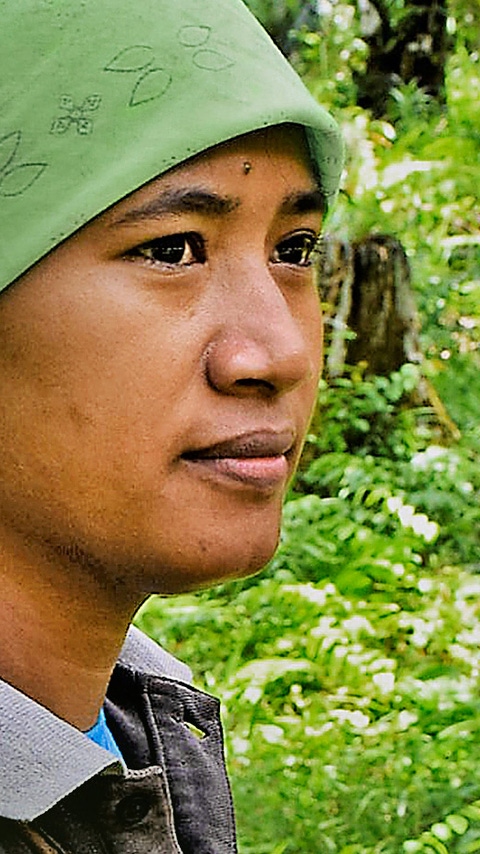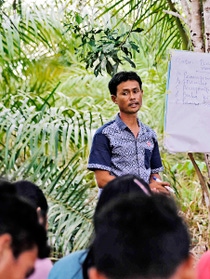40kilograms of oil
That’s how much a palm tree produces every year. The fruit can be harvested every 10 days and each fruit contains 30 to 35 percent oil.

Reportage
Global consumption of palm oil is growing fast, but the costs to the environment are high.
Novice in mediji
Forty percent of the palm and palm kernel oil produced globally comes from smallholder farmers, many of whom are in Indonesia. Helping them grow oil palm without any adverse effects on the environment will have a major impact.
West Kalimantan is an area of swampy lowlands, rivers and forest on the Indonesian part of the island of Borneo. Lying on the equator, it is hot and humid much of the year – an ideal environment for growing oil palm, the plant from which palm oil and palm kernel oil are derived. This is where Petrus Purba and Suwarni live and work with their families. Suwarni is a farmer. Alongside oil palm she also taps rubber and works part-time in a local preschool. Purba is a trainer from the Farmers’ Field School. A graduate of the Agricultural Vocational School in Sintang, he grows oil palm on his 3.5-hectare land – a typical size for many smallholdings here.
Indonesia is now the number one producer of palm oil in the world, having recently overtaken Malaysia. A rapid rise in global demand over the past few decades has made it an attractive crop for growers. Today it is the main export earner for the Indonesian economy, contributing around $18 billion in 2016 and employing millions of Indonesians. Over 10 million hectares of the country’s land is now planted with oil palm.
I feel proud that I can now provide a good life for my children and family.”
For a smallholder like Suwarni, it can make a major difference to the family’s standard of living. “My parents are farmers but they cultivate vegetable crops. I saw the difference between the crops and was more interested in oil palm,” she says. “The yields are more profitable and for every fresh fruit bunch harvested, it is guaranteed money. But you need determination to succeed.”
Many farmers in Indonesia are new to oil palm, having previously farmed rubber or rice, and lack the expertise to grow it efficiently. Learning how and where to plant, and when and how to fertilize, brings immediate tangible benefits like increased yields and additional profits.
This is the kind of training that Purba provides. The Farmers’ Field School is part of a project supported by BASF in collaboration with the consumer goods company Henkel and the development organization Solidaridad. The teachers are employed by a local cooperative, Credit Union Keling Kumang, which has more than 160,000 members. The focus is not only on efficient production but, equally important, on sustainable farming methods and occupational health and safety standards. Farmers are taught how to make better use of the land rather than open up new plantations. They learn about the role that forests and peatlands play for wildlife, indigenous people and the environment, and about the whole palm oil supply chain. The ultimate aim is for smallholders such as Suwarni to adopt the sustainable practices that allow them to gain RSPO certification. Meeting the complex certification requirements is costly and difficult, which is why they need support.
The project currently reaches around 5,500 farmers in Indonesia. Classes take place in the field and farmers are able to talk about issues that concern them. “They ask a lot about fertilization and seed selection,” says Petrus. He attended the Farmers’ Field School himself before becoming a trainer. “I want to train other farmers how to cultivate oil palm. I want everyone to have good yields because oil palm is the main commodity here,” he says.
40kilograms of oil
That’s how much a palm tree produces every year. The fruit can be harvested every 10 days and each fruit contains 30 to 35 percent oil.
For Suwarni, the benefits were quickly evident: “We used to fertilize every 6 months. Now we know it should be every 3 to 4 months. We learned that to reduce cost and preserve the environment, we only need to spray crop protection products along the harvest lane instead of the whole area. I can already see the savings,” she says.
The oil palm industry is welcome here, as long as the environment is preserved.”
“Smallholders are mostly family businesses. They are entrepreneurs who want information that will help build their business so that they can improve their livelihood and enable their children to go to school and university. They have a huge desire to make it work,” says Xavier Susterac, Senior Vice President BASF Personal Care Europe. “We need to support them in adopting sustainable agricultural practices. With RSPO certification they can be a major part of the future sustainable supply chain.” Suwarni sums up the motivation for her and other smallholders: “Previously, there were times when food was short. Now, we can provide enough for our family. My dream is for my children to live a better life than their parents.“

